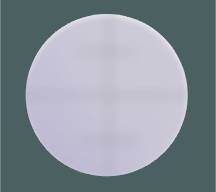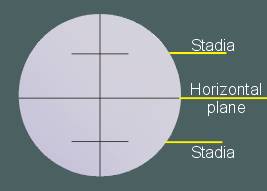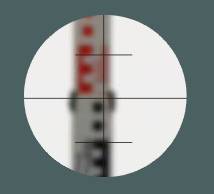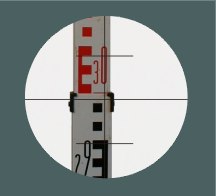Through the telescope
The aim of this tutorial is to demonstrate how to read a levelling staff that conforms to British Standard 4484.
Focus the reticule.
 The
reticule (or diaphragm) is a glass plate with fine lines etched on it
to provide the horizontal reference and stadia marks for estimating distance.
When first looking through the telescope rotate the eye piece to bring
the reticule in to sharp focus.
The
reticule (or diaphragm) is a glass plate with fine lines etched on it
to provide the horizontal reference and stadia marks for estimating distance.
When first looking through the telescope rotate the eye piece to bring
the reticule in to sharp focus.
Each observer will need to focus the reticule to allow for their own eye.
Failure to do so will cause parallax, where a small movement of the eye's position will cause the horizontal lines to give a different staff reading.
 With
the eye piece focused you will see a vertical and a horizontal line dividing
the field of view. The middle horizontal line marks the horizontal plane
through the telescope (height of collimation) and is the reference for
all height readings.
With
the eye piece focused you will see a vertical and a horizontal line dividing
the field of view. The middle horizontal line marks the horizontal plane
through the telescope (height of collimation) and is the reference for
all height readings.
There may also be two short stadia lines. Stadia are used for measuring the distance to the staff by multiplying the difference between the two stadia readings by a constant (usually 100).
Focus on the staff
 Align
the telescope on the staff using the gun sight on the top of the instrument
and gently rotating the telescope by hand.
Align
the telescope on the staff using the gun sight on the top of the instrument
and gently rotating the telescope by hand.
Using the side focussing screw bring the staff in to sharp focus.
Fine adjustment of the alignment can be made with the tangent screw.
Check that the spirit level bubble is within the central portion of the scale before reading the staff.
 In
this view the staff reading is 2.993
In
this view the staff reading is 2.993
Upper
stadia = 3.040
Lower stadia = 2.946
Stadia difference = 0.094
Distance to staff = 0.094 x 100 = 9.4 metres
Note that stadia distances have a low level of accuracy, one mm error in staff reading gives a distance error of 0.1 metre